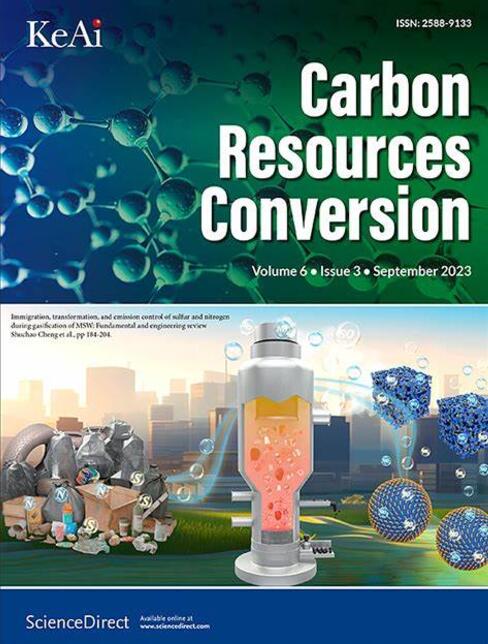微量金属对两级厌氧消化棕榈油厂废水产氢和甲烷的协同效应
IF 7.5
3区 环境科学与生态学
Q2 ENERGY & FUELS
引用次数: 0
摘要
通过添加微量金属(Mo2+、Ni2+、Co2+和Fe2+),优化了棕榈油厂废水的两级厌氧消化(POME)。最佳浓度为10 mg·L−1 Mo2+、6 mg·L−1 Ni2+、6 mg·L−1 Co2+和10 mg·L−1 Fe2+,可显著提高沼气产率,氢气产率提高86.4%(29.5±0.9 ~ 55.0±2.1 mL-H2·g−1 vs),甲烷产率提高84%(173.8±7.8 ~ 320.0±8.4 mL-CH4·g−1 vs)。气体成分得到改善,H2含量从18.5%增加到32.0%,CH4含量从58.2%增加到72.5%。在4天的HRT制氢和20天的HRT产甲烷时,工艺效率最高,金属去除率为93.5 - 94.8%。统计分析表明,金属浓度与酶活性之间存在较强的相关性(R2 = 0.94, p <;0.001)和酶活性与沼气产量的关系(R2 = 0.92, p <;0.001)。代谢物谱显示,H2期乙酸增加81%(3800±120 mg·L−1),丁酸增加93%(2900±95 mg·L−1),丙酸减少57%。H2阶段以热厌氧菌为主,CH4阶段以甲烷杆菌(Methanobacter sp.)和甲烷菌(Methanosarcina sp.)为主,其丰度受添加微量金属的影响。通过精确的控制系统(温度稳定指数为0.95±0.05,pH稳定指数为0.92±0.05),快速响应时间(<5 min),保持过程稳定性。COD去除率由65.3%提高到85.2%,金属去除率均超过90%。这些发现表明,通过优化微量金属补充和精确的过程控制策略,可以显著提高沼气产量。本文章由计算机程序翻译,如有差异,请以英文原文为准。

Synergistic effects of trace metals on hydrogen and methane production from palm oil mill effluent using two-stage anaerobic digestion
The two-stage anaerobic digestion of palm oil mill effluent (POME) was optimized through trace metal supplementation (Mo2+, Ni2+, Co2+, and Fe2+). Optimal concentrations were determined as 10 mg·L−1 Mo2+, 6 mg·L−1 Ni2+, 6 mg·L−1 Co2+, and 10 mg·L−1 Fe2+, resulting in significant biogas yield improvements on hydrogen yield increased by 86.4 % (29.5 ± 0.9 to 55.0 ± 2.1 mL-H2·g−1-VS) and methane yield by 84 % (from 173.8 ± 7.8 to 320.0 ± 8.4 mL-CH4·g−1-VS). Gas composition improved, with H2 content increasing from 18.5 % to 32.0 % and CH4 content from 58.2 % to 72.5 %. Maximum process efficiency was achieved at 4-day HRT for hydrogen production and 20-day HRT for methanogenesis with metal removal 0f 93.5–94.8 %. Statistical analysis revealed strong correlations between metal concentrations and enzyme activities (R2 = 0.94, p < 0.001) and enzyme activities with biogas yields (R2 = 0.92, p < 0.001). Metabolite profiles showed an 81 % increase in acetic acid (3,800 ± 120 mg·L−1) and a 93 % increase in butyric acid (2,900 ± 95 mg·L−1), while propionic acid decreased by 57 % in H2 stage. Thermoanaerobacterium thermosaccharolyticum was dominant in the H2 stage, while Methanobacter sp. and Methanosarcina sp. dominated in the CH4 stage, with their abundance influenced by specific trace metal supplementation. Process stability was maintained through precise control systems (temperature stability index of 0.95 ± 0.05 and pH stability index of 0.92 ± 0.05) with rapid response times (<5 min). COD removal efficiency increased from 65.3 % to 85.2 %, while metal removal efficiencies exceeded 90 % for all supplemented metals. These findings demonstrate significant enhancement in biogas production through optimized trace metal supplementation and precise process control strategies.
求助全文
通过发布文献求助,成功后即可免费获取论文全文。
去求助
来源期刊

Carbon Resources Conversion
Materials Science-Materials Science (miscellaneous)
CiteScore
9.90
自引率
11.70%
发文量
36
审稿时长
10 weeks
期刊介绍:
Carbon Resources Conversion (CRC) publishes fundamental studies and industrial developments regarding relevant technologies aiming for the clean, efficient, value-added, and low-carbon utilization of carbon-containing resources as fuel for energy and as feedstock for materials or chemicals from, for example, fossil fuels, biomass, syngas, CO2, hydrocarbons, and organic wastes via physical, thermal, chemical, biological, and other technical methods. CRC also publishes scientific and engineering studies on resource characterization and pretreatment, carbon material innovation and production, clean technologies related to carbon resource conversion and utilization, and various process-supporting technologies, including on-line or off-line measurement and monitoring, modeling, simulations focused on safe and efficient process operation and control, and process and equipment optimization.
 求助内容:
求助内容: 应助结果提醒方式:
应助结果提醒方式:


